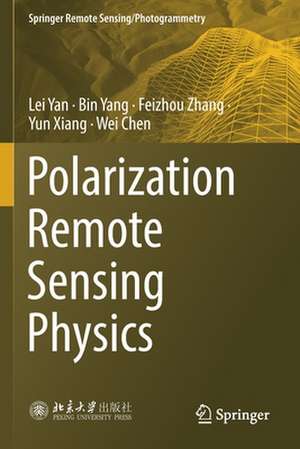Polarization Remote Sensing Physics: Springer Remote Sensing/Photogrammetry
Autor Lei Yan, Bin Yang, Feizhou Zhang, Yun Xiang, Wei Chenen Limba Engleză Paperback – 20 mai 2021
| Toate formatele și edițiile | Preț | Express |
|---|---|---|
| Paperback (1) | 1105.83 lei 6-8 săpt. | |
| Springer Nature Singapore – 20 mai 2021 | 1105.83 lei 6-8 săpt. | |
| Hardback (1) | 1117.34 lei 6-8 săpt. | |
| Springer Nature Singapore – 20 mai 2020 | 1117.34 lei 6-8 săpt. |
Din seria Springer Remote Sensing/Photogrammetry
- 15%
 Preț: 653.98 lei
Preț: 653.98 lei - 24%
 Preț: 847.78 lei
Preț: 847.78 lei - 24%
 Preț: 911.54 lei
Preț: 911.54 lei - 15%
 Preț: 644.18 lei
Preț: 644.18 lei - 24%
 Preț: 694.68 lei
Preț: 694.68 lei - 18%
 Preț: 785.11 lei
Preț: 785.11 lei - 18%
 Preț: 950.52 lei
Preț: 950.52 lei - 18%
 Preț: 895.58 lei
Preț: 895.58 lei - 18%
 Preț: 1112.60 lei
Preț: 1112.60 lei - 18%
 Preț: 946.87 lei
Preț: 946.87 lei - 18%
 Preț: 1244.71 lei
Preț: 1244.71 lei - 18%
 Preț: 1114.02 lei
Preț: 1114.02 lei - 24%
 Preț: 728.29 lei
Preț: 728.29 lei - 24%
 Preț: 895.51 lei
Preț: 895.51 lei - 20%
 Preț: 560.05 lei
Preț: 560.05 lei - 18%
 Preț: 1043.14 lei
Preț: 1043.14 lei - 18%
 Preț: 944.34 lei
Preț: 944.34 lei - 18%
 Preț: 888.18 lei
Preț: 888.18 lei - 18%
 Preț: 892.46 lei
Preț: 892.46 lei - 18%
 Preț: 1005.61 lei
Preț: 1005.61 lei - 24%
 Preț: 844.06 lei
Preț: 844.06 lei
Preț: 1105.83 lei
Preț vechi: 1348.57 lei
-18% Nou
Puncte Express: 1659
Preț estimativ în valută:
211.63€ • 218.62$ • 176.13£
211.63€ • 218.62$ • 176.13£
Carte tipărită la comandă
Livrare economică 26 martie-09 aprilie
Preluare comenzi: 021 569.72.76
Specificații
ISBN-13: 9789811528880
ISBN-10: 9811528888
Ilustrații: XXVII, 337 p. 305 illus., 196 illus. in color.
Dimensiuni: 155 x 235 mm
Greutate: 0.51 kg
Ediția:1st ed. 2020
Editura: Springer Nature Singapore
Colecția Springer
Seria Springer Remote Sensing/Photogrammetry
Locul publicării:Singapore, Singapore
ISBN-10: 9811528888
Ilustrații: XXVII, 337 p. 305 illus., 196 illus. in color.
Dimensiuni: 155 x 235 mm
Greutate: 0.51 kg
Ediția:1st ed. 2020
Editura: Springer Nature Singapore
Colecția Springer
Seria Springer Remote Sensing/Photogrammetry
Locul publicării:Singapore, Singapore
Cuprins
Physical rationale of polarized remote sensing.- Remote sensing of ground objects 1: physical characteristics of multi-angle polarized reflectance.- Remote sensing of ground objects 2: multispectral chemical characteristics of surface polarization reflection.- Remote sensing of ground objects 3: Surface roughness and density structure of polarization reflectance.- Remote sensing of land surfaces 4: Signal-to-background high contrast ratio filtering of polarimetric reflections.- Remote sensing of land surfaces 5: Characteristics of radiative transfer on surface polarization.- Atmospheric remote sensing 1: the nature and physical characteristics of the full-sky polarization pattern.- Atmospheric remote sensing 2: Neutral point areas of atmospheric polarization and land-atmosphere parameter separation.- Atmospheric remote sensing 3: atmospheric polarization characteristics and multi-angular three-dimensional chromatography.- New areas in polarization 1: bionic polarization for automatic navigation using the Earth’s polarization vector field.- New areas in polarization 2: remote sensing for advanced space exploration and global change research.
Notă biografică
Professor Lei YAN is the director of Beijing Key Lab of Spatial Information integration and 3s application (Peking University).
Lei YAN works on Remote Sensing, Geographic Information System and navigation field, and undertakes many related national major projects.
In 2012, Lei YAN won the first prize of Beijing Science and Technology Progress Award (natural science).
In 2013, Polarization Remote Sensing Image System invented by Lei YAN won gold medal of the 41th International Exhibition of Inventions of Geneva.
In 2013, Lei YAN won the third prize of Beijing Science and Technology Progress Award (natural science).
In 2015, Lei YAN won the second prize of National Technology Invention Award.
In 2016, Lei YAN won the honorable mention of the 18th China Patent Award.
In 2017, Polarization Remote Sensing Image System invented by Lei YAN won Gold Medal with the congratulations of the jury of the 45th International Exhibition of Inventionsof Geneva.
Lei YAN works on Remote Sensing, Geographic Information System and navigation field, and undertakes many related national major projects.
In 2012, Lei YAN won the first prize of Beijing Science and Technology Progress Award (natural science).
In 2013, Polarization Remote Sensing Image System invented by Lei YAN won gold medal of the 41th International Exhibition of Inventions of Geneva.
In 2013, Lei YAN won the third prize of Beijing Science and Technology Progress Award (natural science).
In 2015, Lei YAN won the second prize of National Technology Invention Award.
In 2016, Lei YAN won the honorable mention of the 18th China Patent Award.
In 2017, Polarization Remote Sensing Image System invented by Lei YAN won Gold Medal with the congratulations of the jury of the 45th International Exhibition of Inventionsof Geneva.
Textul de pe ultima copertă
This book elaborates on the physical principles of polarization remote sensing. It explains the reflective characteristics of surface objects and atmosphere separately, including theory, experiment, instrument and application. In addition, it introduces how polarization remote sensing works in advanced research programs as it can be used in aviation, astronomy, disaster risk prevention and navigation fields. This book serves as a fundamental and comprehensive reference for researchers and students.
Caracteristici
Summarizes five characteristics of polarization remote sensing, including multi-angle reflection physical features (Chapter 2), multispectral chemical properties (Chapter 3), roughness and density structure properties (Chapter 4), characteristics of info-background high contrast ratio filter (Chapter 5), and the features of radiative energy transfer (Chapter 6) Reveals important connotations of atmospheric polarized remote sensing, including the nature and physical characteristics of the full-sky polarization pattern (Chapter 7), regional characteristics of atmospheric polarization neutral points and decoupling of ground-atmospheric parameters (Chapter 8), and multi-angle stereoscopic observation chromatography of atmospheric particles under full-sky polarization vector field (Chapter 9) Introduces new areas in polarization, including bionic polarization automatic navigation based on earth’s polarization vector field (Chapter 10), polarization remote sensing methods for advanced space detection and a global change study (Chapter 11)
